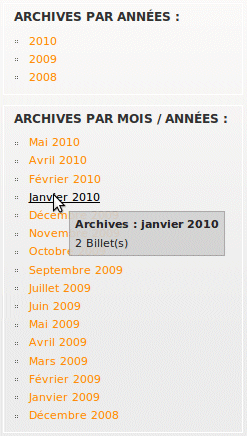Advanced development with eZ Find - part 2 : Indexing additional fields in Solr
Introduction
The first part of this tutorial described the low-level mechanisms of eZ Find, and the way eZ Publish attributes ( names, types ) and Solr fields are mapped. This post describes how eZ Find can dramatically ease development of some functionalities ( avoiding complex template operators and heavy SQL queries ) by automatically indexing additional fields in Solr when an object is published, which can in turn be leveraged for facetting or advanced filtering.
Pre-requisites and target population
This tutorial requires to know how to set up eZ Find. The online documentation describes the required operation in details, there : http://ez.no/doc/extensions/ez_find/2_2.
You should also read and understand the first part of this tutorial :
http://share.ez.no/tutorials/ez-publish/advanced-development-with-ez-find-part-1-datatypes-in-solr-and-ez-find
Step 1 : Presenting the case
The presented case has been chosen for its high educational value. It is a frequently requested feature, is relatively simple to implement and properly illustrates the underlying concept.
News websites, or blog post lists on blogs often propose to filter the content by year, or by a combination of year and month. Usually in this case, a template operator is developed which builds the appropriate SQL queries. This can quickly become complicated, and often has sharp limitations. Taking a look at the eZArchive operator helps understanding what I mean here.
Frequently, the complex SQL machinery required suffers from functional lacks, like access control propagation, language handling, unability to leverage some subtleties of MySQL or PostGreSql. The developer necessarily has to deal with these problematics, since the API is circumvented to directly write SQL statements. Another limitation of this approach is illustrated by the eZArchive operator : only the 'publication_date' parameter is taken into account, and no room is left for using a content-class-specific date attribute.
Let us see how we can develop a year and year & month filter with eZ Find.
Step 2 : Indexing year and year /month in Solr
eZ Find settings ( ezfind.ini, to be overridden in the ezfind.ini.append.php file of your extension ) allow for delegating the indexing process of an eZ Publish datatype to a given PHP class :
[SolrFieldMapSettings] CustomMap[ezdate]=ezfSolrDocumentFieldDate
Our PHP class, randomly named , ezfSolrDocumentFieldDate inherits from the ezfSolrDocumentFieldBase class, must be added to the /extension/myextension/classes folder and must inherit the following skeleton :
<?php
class ezfSolrDocumentFieldDate extends ezfSolrDocumentFieldBase
{
public static function getFieldName( eZContentClassAttribute $classAttribute, $subAttribute = null, $context = 'search' )
{
// return the fieldname like : attr_mydate_d
}
public function getData()
{
// return the array keys (fieldname => value), like : array('attr_mydate_dt' => '2010-04-30T00:00:00Z')
}
}
?>Step 3 : Understanding the role of the getFieldName() method
This method is invoked the attributes names (within eZ Find) to Solr field names. For instance, when building a facet using the following syntax : 'mycontentclass/mydateattribute', this method receives 'mydateattribute' and should return 'attr_mydateattribute_dt'. Here is how we are going to implement the body of this method :
- If a subattribute is specified ( for instance : 'mycontentclass/mydateattribute/year' ), then return the composed name of the subattribute.
- If no subattribute is specified, then execute the associated parent class code
- Important : to make sure the written code is generic enough, and avoid hard-coding the Solr field names, we will use the handy generateSubattributeFieldName and generateAttributeFieldName methods.
const DEFAULT_SUBATTRIBUTE_TYPE = 'date';
public static function getFieldName( eZContentClassAttribute $classAttribute, $subAttribute = null, $context = 'search' )
{
switch ( $classAttribute->attribute( 'data_type_string' ) )
{
case 'ezdate' :
{
if ( $subAttribute and $subAttribute !== '' )
{
// A subattribute was passed
return parent::generateSubattributeFieldName( $classAttribute,
$subAttribute,
self::DEFAULT_SUBATTRIBUTE_TYPE );
}
else
{
// return the default field name here.
return parent::generateAttributeFieldName( $classAttribute, self::getClassAttributeType( $classAttribute, null, $context ) );
}
} break;
default:
{} break;
}
}Step 4 : Understanding the role of the getData() method
This method is invoked to extract data from eZ Publish, and prepare it prior to indexing in Solr. This method is the place to add additional fields like 'year' et 'yearmonth'. Once these new fields (subattributes) are indexed, we will leverage them by facetting or filtering on them, using the following, classical syntax:
- 'mycontentclass/mydateattribute/year', translated in Solr under : 'subattr_date-year_dt'
- 'mycontentclass/mydateattribute/yearmonth', translated in Solr under : 'subattr_date-yearmonth_dt'
public function getData()
{
$contentClassAttribute = $this->ContentObjectAttribute->attribute( 'contentclass_attribute' );
switch ( $contentClassAttribute->attribute( 'data_type_string' ) )
{
case 'ezdate' :
{
$returnArray = array();
// Get timestamp attribute value
$value = $this->ContentObjectAttribute->metaData();
// Generate the main filedName attr_XXX_dt
$fieldName = parent::generateAttributeFieldName( $contentClassAttribute,
self::DEFAULT_ATTRIBUTE_TYPE );
$returnArray[$fieldName] = parent::convertTimestampToDate( $value );
// Generate the yearmonth subattribute filedName subattr_year_dt
$fieldName = parent::generateSubattributeFieldName( $contentClassAttribute,
'year',
self::DEFAULT_SUBATTRIBUTE_TYPE );
$year = date("Y", $value); // Get Year value : 2010
$returnArray[$fieldName] = parent::convertTimestampToDate( strtotime($year.'-01-01') );
// Generate the yearmonth subattribute filedName subattr_yearmonth_dt
$fieldName = parent::generateSubattributeFieldName( $contentClassAttribute,
'yearmonth',
self::DEFAULT_SUBATTRIBUTE_TYPE );
$month = date("n", $value); // Get Month value : 3
$returnArray[$fieldName] = parent::convertTimestampToDate( strtotime($year.'-'.$month.'-01') );
return $returnArray;
} break;
default:
{} break;
}
}
}
Note:
$returnArray contains an associative array looking like this ( using var_dump ) :
array(3) {
["attr_date_dt"]=>
string(24) "2008-12-28T00:00:00.000Z"
["subattr_date-year_dt"]=>
string(24) "2008-01-01T00:00:00.000Z"
["subattr_date-yearmonth_dt"]=>
string(24) "2008-12-01T00:00:00.000Z"
}
Note :
Solr uses the ISO 8601 date format, of the form : '2010-04-30T00:00:00Z'. The parent class ( ezfSolrDocumentFieldBase ) exposes the convertTimestampToDate() methodm used to convert a timestamp to an ISO 8601 formatted date.
Step 5 : Building the facet navigation through a template
Our per-year and per year/month data are now available, indexed in Solr. Left is only to build the facet navigation, the usual way :
{def $search_yearmonth=fetch( ezfind, search,
hash( 'query' , '',
'facet', array(
hash('field', 'billet/date/year',
'sort', 'alpha',
'limit', 20 ),
hash('field', 'billet/date/yearmonth',
'sort', 'alpha',
'limit', 20 )
),
'class_id', array('billet'),
'subtree_array', array(2)
))}
{def $search_extras_year=$search_yearmonth['SearchExtras'].facet_fields[0].nameList|reverse}
{def $search_extras_yearmonth=$search_yearmonth['SearchExtras'].facet_fields[1].nameList|reverse}
{def $date_count = 0
$date_ts = 0}
<li id="blog_block_10" class="colonne_block">
<h1>Archives par années :</h1>
<ul class="list {$current_css}">
{foreach $search_extras_year as $facetID => $datevalue}
{set $date_count = $search_yearmonth['SearchExtras'].facet_fields[0].countList[$facetID]}
{set $date_ts = $datevalue|strtotime}
<li><a href={concat('/Blogs/(year)/',$date_ts|datetime( 'custom', '%Y' ))|ezurl} title="Archives : {$date_ts|datetime( 'custom', '%Y' )} // {$date_count} Billet(s)">{$date_ts|datetime( 'custom', '%Y' )}</a></li>
{/foreach}
</ul>
</li>
<li id="blog_block_11" class="colonne_block">
<h1>Archives par mois / années :</h1>
<ul class="list {$current_css}">
{foreach $search_extras_yearmonth as $facetID => $datevalue}
{set $date_count = $search_yearmonth['SearchExtras'].facet_fields[1].countList[$facetID]}
{set $date_ts = $datevalue|strtotime}
<li><a href={concat('/Blogs/(year)/',$date_ts|datetime( 'custom', '%Y' ),'/(month)/',$date_ts|datetime( 'custom', '%n' ))|ezurl} title="Archives : {$date_ts|datetime( 'custom', '%F %Y' )} //{$date_count} Billet(s)">{$date_ts|datetime( 'custom', '%F %Y' )|upfirst}</a></li>
{/foreach}
</ul>
</li>
{undef $date_ts $date_count $search_yearmonth $search_extras_yearmonth}
Note :
The presented fetch is quite basic, for an easier understanding of the mechanism. This code needs to be elaborated to achieve the expected functional result (be able to use filter for instance). This is however not this tutorial's purpose, the official documentation already giving all hints for doing this.
2nd Note :
The 'sort', 'alpha' statement does not actually specify an alphabetical sort. It rather helps specifying that no 'count' sort should occur (number of items matching a given facet). In this case, Solr automatically uses an 'increasing' sort, based on its index and the datatype of the concerned field (this explains the usage of the reverse operator to get an 'increasing' list).
Conclusion
This second post out of three describes how to add additional fields in Solr/Lucene's index when indexing content objects. This allows for :
- Easing or even making possible the construction of some filters, search sort methods or content navigation schemes
- Optimizing development time
- Optimizing response time by alleviating or removing load from the SQL stack
I would like to thank Nicolas Pastorino for translating this tutorial to english, and Paul Borgermans for his availability.
Resources
-
eZ Find 2.2 official documentation :
http://ez.no/doc/extensions/ez_find/2_2 - eZ Find source code : here
-
Tutorial on eZPedia.org : how to create a template operator :
http://ezpedia.org/ez/template_operators - ezarchive template operator source code : here
- eZ Find settings files : here
- ezfSolrDocumentFieldBase class source code : here
- Apache Solr Wiki :http://wiki.apache.org/solr/
This article is available for offline reading :
Gilles Guirand - Advanced development with eZ Find - part 2 - Indexing additional fields in Solr - PDF version
About the author : Gilles Guirand
Gilles Guirand is a certified eZ Publish Developer. He is widely acknowledged by the community to be one of the national experts on highly technical and complex eZ Publish issues. With over 12 years experience in designing complex web architectures, he has been the driving force behind some of the most ambitious eZ Publish Projects: Web Site Generators, HighAvailability, Widgets, SOA, eZ Find, SSO, Web Accessibility and IT systems Integrations.
License
This work is licensed under the Creative Commons – Share Alike license ( http://creativecommons.org/licenses/by-sa/3.0 ).


